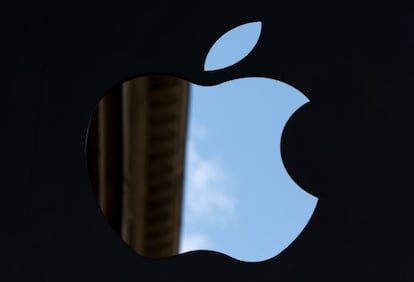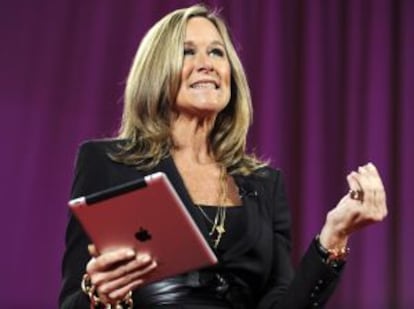From ‘Apple Computer’ to ‘Apple Lifestyle’
New exec Angela Ahrendts opens the door to a collection of luxury accessories bearing the bitten apple logo

When Steve Jobs changed the rainbow-colored logo for a silvery one, he was taking the first step toward transforming Apple into something more than a computer manufacturer. The next move came in 2007, coinciding with the creation of the iPhone, when the company dropped the second word in its name, “Apple Computer.” The third shift comes courtesy of Tim Cook: with the spectacular signing of Burberry CEO Angela Ahrendts, Apple will sooner or later become “Apple Lifestyle.”
The Apple logo is worth 98 billion dollars (71.7 billion euros), four times more than Louis Vuitton (LV), the world’s top luxury brand according to an annual report by Interbrand, a major brand consulting firm. No brand in the world is more valuable than Apple. For the first time in 13 years Coca-Cola’s dominance has ended, and The Real Thing has given way to Think Different. Ahead of LV, which ranks 17th on the top global brand list, there are 11 tech-related brands.
And yet while Louis Vuitton has dozens of products on its catalogue, Apple can just barely offer buyers half a dozen. Until now it didn’t know how (or didn’t feel the need) to make the most of its positive global image by reaching out beyond the world of technology. Its “cool” image, which Jobs tended to carefully, has yet to extend to wider fields of consumer goods. That is where Ahrendts comes in – and not just to put together beautiful display windows for Apple Stores.
Burberry (which Ahrendts has been heading up since 2006) and many other luxury firms have been broadening their customer base for decades. Montblanc made the jump from fountain pens to briefcases and diaries; Prada was not satisfied with its traditional customer portfolio and is now equipping athletes; Loewe is designing kitbags for soccer players and airport luggage conveyor belts unfailingly feature a suitcase with a prestigious logo going around in circles.

Until recently, Apple was technologically unbeatable; now it is intermittently so. At least, its supremacy is now debatable, which is news in itself. Its computers, smartphones and tablets lack the technical superiority of old, and this is no longer the deciding factor for customers. Given a more level playing field, Apple products lose out on the price front. And in future Apple will no longer be able to keep competing in the field of constant technological upgrades to the same product (a smartphone or a tablet), which its until-now faithful followers will cease to renew with the frequency the company would like. The solution, like other lifestyle brands such as Hermès or Mercedes, lies in expanding one’s product catalogue.
Apple’s profit margin is unique to the tech industry. Given the choice between the two classic commercial strategies — either selling a lot with small profits per sale or selling a few items with big margins — Apple always favored the latter, just like luxury brands. But the Cupertino-based firm has seen its profit margin decline from 42.8 percent to 36.9 percent in under a year, and this figure will keep falling because of aggressive competition, as long as it continues to limit itself to technology.
A few things are going to change with Ahrendts’ arrival, and we’re not just talking about store clerks trading in their tees for formal shirts. There is no reason why those display windows, either physical or virtual, should not include headphones, digital pens with handwriting recognition, and — why not? — electric bikes and running shoes that can send information to your iPhone about your exercise, just like Nike is already doing.
In the 1990s, Jobs perceived that people had lost their fear of computers and changed the rainbow colors for a monochromatic apple
Whether consciously or not, Apple has already been taking steps in that direction. Its initial multicolored logo was meant to humanize the computer, a forbidding contraption back in the 1970s; in the 1990s, Jobs perceived that people had lost their fear of computers and changed the rainbow colors for a monochromatic apple (first black, then white since 2003). The slogan “Think Different” underscored the notion that this brand was not going to be like all the others; now Cook has hired Ahrendts to bring about a whole Apple Lifestyle, although a few things still remain to be done:
Forget about the “low-cost” market. The 5C smartphones that come in colors reminiscent of Calippo popsicles are the best evidence of what happens when a company starts to falter: it comes up short and fails to convince its faithful customers, while also failing to capture new clients as it meant to do. The iPhone 5C is selling less well than expected, while the more expensive 5S is selling better. A cellphone that looks like a Parcheesi piece and comes with a 500-euro price tag, 100 euros less than its more expensive mate, has no real mission in life. The Gruyère-like case full of drilled holes will soon be joining the museum of horrors and act as a tribute to the persuasive abilities of Tim Cook, who still managed to hire the director of Burberry despite the cheesy cases.
More design, fewer technological upgrades. The competition has caught up with Apple on the tech front, but not in terms of the care that goes into each detail, from the packaging to the shows. Ahrendts will not have to make life hard for herself with a super-duper intelligent watch; all she really needs is a simple set of headphones to issue and receive voice commands, or perhaps a pair of glasses — nothing as supersonic as Google’s Glass; a simple Bluetooth device that connects to the cellphone will do, and it will justify the Apple logo on the sidepiece.
Expand the female customer base. Technology is not traditionally a female passion, but smartphones and tablets apparently are. Despite this, Apple has a loyal if underutilized pool of women customers. Ahrendts will have an easy job of it here. She has a good logo and a very attractive design working for her, and they will help extend the Apple brand to a broader spectrum of goods that can be embedded with technology and thus remain faithful to the company’s origins. In fact, the Mini tablet – Cook’s great success — is the world’s bestselling tablet and its customers happen to be mostly women.
Diversify, yes, but don’t be vulgar. Ahrendts diversified Burberry’s catalogue, but at the same time she eliminated the agreements with franchises and prevented their clothing from ending up on street markets (and they were not always fakes, either). Belts, scarves and gloves could soon bear the Apple logo, and they will doubtless be the target of forgery, but this is something that luxury brands have always had to live with, unlike other sectors who still wring their hands over internet piracy.
A global brand but still very local. It may be the most valuable brand in the world, but it is still very US-focused. It is a desirable brand, but it has yet to satisfy impulsive shopping by opening stores in more cities and making its website more attractive for a wider audience. Sooner or later it will also reduce its dealership agreements.
Apple has lost the ability to lead the way in technology, now that the competition is constantly coming up with similar devices. An accessory line would allow it to be more prolific, sell to a broader spectrum and free itself from the bondage of a calendar of new releases that can only lead to failure.
Back in the 19th and 20th centuries, luxury brands were anchored in fashion and jewelry. But in the 21st century they will have computer written all over them. Angela Ahrendts will make sure of that.
Tu suscripción se está usando en otro dispositivo
¿Quieres añadir otro usuario a tu suscripción?
Si continúas leyendo en este dispositivo, no se podrá leer en el otro.
FlechaTu suscripción se está usando en otro dispositivo y solo puedes acceder a EL PAÍS desde un dispositivo a la vez.
Si quieres compartir tu cuenta, cambia tu suscripción a la modalidad Premium, así podrás añadir otro usuario. Cada uno accederá con su propia cuenta de email, lo que os permitirá personalizar vuestra experiencia en EL PAÍS.
¿Tienes una suscripción de empresa? Accede aquí para contratar más cuentas.
En el caso de no saber quién está usando tu cuenta, te recomendamos cambiar tu contraseña aquí.
Si decides continuar compartiendo tu cuenta, este mensaje se mostrará en tu dispositivo y en el de la otra persona que está usando tu cuenta de forma indefinida, afectando a tu experiencia de lectura. Puedes consultar aquí los términos y condiciones de la suscripción digital.








































